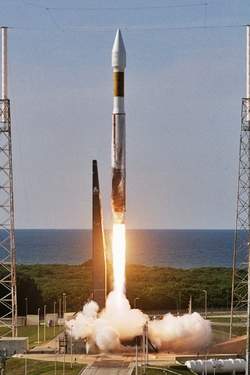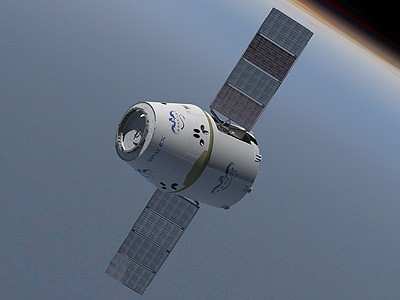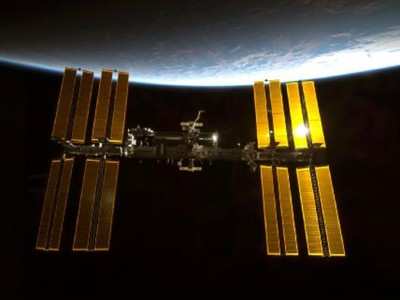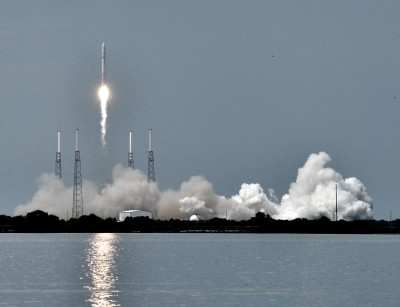Responds To What It Calls Recent Misperceptions Related To U.S.
Human Spaceflight
 The Commercial Spaceflight
Federation, which continues to be a strong supporter of a robust
NASA, says there are still a number of misperceptions relating to
human spaceflight, including commercial human spaceflight.
The Commercial Spaceflight
Federation, which continues to be a strong supporter of a robust
NASA, says there are still a number of misperceptions relating to
human spaceflight, including commercial human spaceflight.
The CSF says that commercial companies are not relying on
untested and unproven companies or launch vehicles. The Commercial
Crew Program announced by President Obama in February will include
the use of highly proven launch vehicles such as the Atlas V, which
has achieved a perfect record of 21 consecutive successful flights
to orbit. In addition to Atlas V, the commercial Delta IV has 13
consecutive successful flights, and the Falcon 9 recently reached
orbit on its first flight, with over a dozen more Falcon 9 flights
scheduled in the next few years.
The Commercial Crew competition will include highly experienced
firms, including major aerospace prime contractors, such as Boeing,
which is developing the CST-100 commercial crew capsule under
CCDev, and Boeing has built nearly every U.S. human spacecraft
since Mercury. The list of companies winning CCDev or COTS
demonstrates the wide experience base of potential competitors,
such as Boeing (158,000 employees), United Launch Alliance (3,900
employees), Orbital (3,600 employees), Sierra Nevada Corporation
(2,000 employees), and SpaceX (1,000 employees).
 In addition, commercial companies,
such as United Launch Alliance, have already proven the ability to
successfully carry high-value cargo to orbit. Given the urgency of
closing the gap, the CSF says Commercial Crew should be promptly
started. Only two companies are developing cargo capabilities under
the NASA Commercial Orbital Transportation Services (COTS) program,
so it is not logical for the other companies to be forced to wait
for the completion of the COTS Cargo program. The Department of
Defense already trusts commercial launch vehicles such as the
proven Atlas V to launch cargo worth billions of dollars per
mission and on which the safety of troops overseas depends.
These vehicles are also entrusted by NASA to handle some of the
most safety-critical applications in the civil space sector. For
example, the Atlas V is Category 3 certified by NASA for launch of
NASA's most critical payloads.
In addition, commercial companies,
such as United Launch Alliance, have already proven the ability to
successfully carry high-value cargo to orbit. Given the urgency of
closing the gap, the CSF says Commercial Crew should be promptly
started. Only two companies are developing cargo capabilities under
the NASA Commercial Orbital Transportation Services (COTS) program,
so it is not logical for the other companies to be forced to wait
for the completion of the COTS Cargo program. The Department of
Defense already trusts commercial launch vehicles such as the
proven Atlas V to launch cargo worth billions of dollars per
mission and on which the safety of troops overseas depends.
These vehicles are also entrusted by NASA to handle some of the
most safety-critical applications in the civil space sector. For
example, the Atlas V is Category 3 certified by NASA for launch of
NASA's most critical payloads.
The Commercial Spaceflight Federation says that developing a low
Earth orbit Gemini-class capability (which is the historical human
spaceflight project most similar to Commercial Crew) is a simpler,
and therefore shorter, task than developing an Apollo or
Orion-class capability. The first piloted Gemini flight to orbit
was achieved only about 3 years and 3 months after McDonnell
accepted a contract to develop Gemini. Today, it says the fastest
way for America to regain its ability to send astronauts to the
International Space Station is to develop a simple Gemini-class
capability rather than waiting for a more complex Apollo-sized
system. Because Commercial Crew funds multiple redundant
capabilities, schedule delays with any one company will not delay
the availability of astronaut launch capability. Commercial Crew is
actually less vulnerable to schedule slips than a program such as
Ares I that has only one provider. With Commercial Crew, a delay
with a single competitor does not increase the gap because other
competitors are progressing in parallel, while under the old plan,
each delay with Ares I does increase the gap
In terms of cost, as the Augustine Committee stated, "Gemini is
the closest historical program in scope to the envisioned
commercial crew taxi." In GDP-inflator-corrected FY 2009 dollars,
the DDT&E [design, development, test, and evaluation] cost of
this program was about $2.5-3 billion, depending on the accounting
for test flights. Since that time, technology for human spaceflight
has benefited from 40+ years of technology advances and lessons
learned. If Gemini were built today, it would likely cost even less
to develop.

Gemini 7
Commercial Crew does not require spending money to develop new
launch vehicles, only capsules. The launch vehicles already exist.
Atlas V has flown 21 consecutive times to orbit successfully, Delta
IV has flown 13 consecutive times to orbit successfully, and Falcon
9 just had a successful flight to orbit. Not needing to develop
all-new launch vehicles is a substantial cost advantage of
Commercial Crew.
The Commercial Spaceflight Federaltion asserts that the new plan
increases flexibility, in that it funds multiple redundant
capabilities to transport crew to LEO. This will mean that NASA's
human spaceflight program will no longer be solely dependent on any
one single domestic vehicle. America will finally have
"assured access to space" for astronauts, similar to how military
satellites have assured access to space by using both the Delta and
Atlas. Achieving that assured access for astronauts, via multiple
commercial capabilities, will dramatically improve our ability to
fully utilize the International Space Station.
Commercial Crew is a continuation of existing national policy.
The 2008 NASA Authorization Act endorsed commercial crew,
stating:
"In order to stimulate commercial use of space, help maximize
the utility and productivity of the International Space Station,
and enable a commercial means of providing crew transfer and crew
rescue services for the International Space Station, NASA shall
issue a notice of intent, not later than 180 days after the date of
enactment of this Act, to enter into a funded, competitively
awarded Space Act Agreement with two or more commercial entities
for a Phase 1 Commercial Orbital Transportation Services (COTS)
crewed vehicle demonstration program."

Atlas V Launch
Similarly, the 2008 NASA Appropriations House report endorsed
commercial crew. It "encourage[d] NASA to consider exercising its
option for the Commercial Cargo (COTS) Capability D (crew
transport) as soon as possible."
While some say the data shows commercial vehicles are less safe
than other vehicles such as Ares I, the Commercial Spaceflight
Federation holds that the demonstrated track records of commercial
vehicles, combined with numerous upcoming manifested flights, means
that the family of commercial vehicles already has, and will
continue to have, a much stronger track record than other vehicles
such as Ares I. The Atlas family of rockets has had over 90
consecutive successes, and additional unmanned flights will occur
over the next few years before any astronaut flights begin. By
contrast, NASA was planning to place astronauts on just the second
full-up orbital flight of the Ares I system. Furthermore, the first
crewed flight of Ares I will not occur until the year 2017 as
determined by the Augustine Committee. At the planned rate of two
Ares I flights per year, it would take the Ares I rocket until at
least the year 2025 to match the demonstrated reliability that the
Atlas V rocket already has today.
Private companies understand that they will not be in business
if the systems they develop are not safe. In fact, private industry
recognizes that it must increase safety from that demonstrated in
the past in order to fulfill its vision of greatly increasing human
activity in space, and the commercial industry is planning to meet
or exceed the safety standards that NASA applies to its own
vehicles. Thirteen former NASA astronauts who have accumulated a
total of 42 space missions, stated in an October Wall Street
Journal op-ed that commercial spaceflight can be conducted
safely.

SpaceX Dragon Artist's Concept
In the area of cost, the CSF says that the development cost of
Ares I plus a crew-launch-capable Orion is at least $35 billion ...
6 times more expensive than the Commercial Crew Program that will
develop multiple redundant systems. The $35 billion cost figure is
a direct NASA quote from the June 17, 2009 New York Times. In
addition, the per-flight costs to transport astronauts to the
International Space Station on Ares I would significantly exceed
that of simpler commercial systems.
There are at least four distinct reasons for these cost savings
under Commercial Crew:
- Proven launch vehicles already exist, such as Atlas V, and
others have demonstrated successful orbital flights, such as Falcon
9, substantially reducing the amount of new hardware needing
development.
- Commercial vehicles also launch commercial communications
satellites and national security payloads, leading to an increased
flight rate that reduces per-flight cost. By contrast,
NASA-unique vehicles are prohibited from launching commercial
satellites, so there are usually fewer flightsamong
which to share costs.
- Low Earth Orbit transportation is less difficult than extended
missions to the Moon, so a capsule built just for LEO is less
expensive.
- Unlike traditional programs, commercial procurements utilize
fixed-price, pay-for-performance, milestone-based agreements and
leverage the power of competition between multiple providers.
While it is true that non-NASA human spaceflight markets have
implications for regulatory frameworks and corporate business
approaches, they are not the primary source of cost savings for the
NASA government customer. The benefits of additional commercial
markets for human spaceflight are to increase the safety,
reliability, and diversity of the services offered and further
reduce the cost to NASA.

Space Station servicing is an urgent need that requires the
quicker, simpler solution of the Commercial Crew program that is
optimized just for the Space Station. Heavy-lift systems designed
to go beyond low Earth orbit are far more capable than is needed
for low Earth orbit operations, so for the specific mission of
Space Station servicing they are neither cost-effective, nor
available in a timely manner. While it is entirely appropriate for
NASA to develop heavy-lift systems for exploration, those systems
are not the solution to the needs of the Space Station. Because
Commercial Crew and heavy-lift serve entirely separate missions,
the Commercial Spaceflight Federation feels the ability to utilize
the Space Station depends entirely on whether Commercial Crew is
robustly funded.
Since the $6 billion requested for the Commercial Crew program
is much smaller than the $35 billion Ares I-Orion effort, not to
mention that Ares V costs would be significantly larger, diverting
money from Commercial Crew would only fund a small fraction of a
system that, even if fully funded, would not come online until 2017
or later, increasing the spaceflight gap and jeopardizing our
utilization of the International Space Station.
Launch vehicles such as Atlas, Delta, and Falcon already have
multiple customers today for the launching of satellites and cargo.
The Augustine Committee report, in the section on Commercial Crew,
pointed out "the existing markets of ISS cargo to low-Earth orbit,
science and national security space satellite missions, and
commercial satellite launches." The costs of the launch vehicle are
thus already shared among multiple customers.

Falcon 9 Launch
Investment in the commercial spaceflight industry offers the
opportunity for America to win back a larger share of the
international launch market. Norman Mineta, who served under the
Bush Administration as the Secretary of Transportation, and under
the Clinton Administration as the Secretary of Commerce, stated in
a recent op-ed, "With Russia, China and India close on our heels,
the only way we can maintain our hard-won leadership in space
transportation is by employing America's unique entrepreneurial
strength. Obama's new plan for NASA does exactly that."
 ANN's Daily Aero-Linx (04.13.24)
ANN's Daily Aero-Linx (04.13.24) ANN's Daily Aero-Term (04.13.24): Beyond Visual Line Of Sight (BVLOS)
ANN's Daily Aero-Term (04.13.24): Beyond Visual Line Of Sight (BVLOS) Airborne 04.09.24: SnF24!, Piper-DeltaHawk!, Fisher Update, Junkers
Airborne 04.09.24: SnF24!, Piper-DeltaHawk!, Fisher Update, Junkers Aero-News: Quote of the Day (04.14.24)
Aero-News: Quote of the Day (04.14.24) ANN's Daily Aero-Term (04.14.24): Maximum Authorized Altitude
ANN's Daily Aero-Term (04.14.24): Maximum Authorized Altitude









